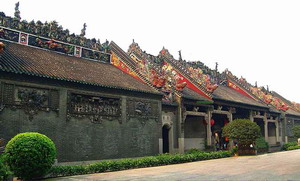|

Chen's Ancestral Temple is located on Zhongshan Qilu (7th) with a history of over one hundred years and still in its original shape. The construction began in 1894, sponsored by Chen Xianglin, a founder of the local charity organization, together with Chen Ruinan and Chen Yaonan, who returned from abroad. The buildings are known for their exquisite and mythical decorations, such as the brick carvings of historic figures.
The construction was intended as a family memorial temple for all the Chens in the 27 counties in Guangdong Province. Later it functioned as an academy as well, where students of the Chen clan gathered to study before their going to the capital to take the imperial examination in Beijing. And in the early 20th century, the buildings were used to house various institutions. First, there was the Chen Industrial College and then several other schools were also founded there, including Guangdong Public School and Juxian Middle School. It was also used as a family shrine for the Chens to pay tribute to their ancestors every spring and autumn.
During its past weathered century, the Chen Clan Academy has managed to survive a dozen disasters. During the Anti-Japanese War (1937-1945), for example, it happened that a bomb should be dropped in the shrine, and fortunately, it didn't explode. For a time, the local government made it a garrison. Ignorant soldiers nearly wrecked the relics, destroying the buildings and decorations carelessly. Some more ruthless ones even cut the heads off of the carved figures to sell at the underground market.
This priceless national treasure had a truly narrow escape during the Cultural Revolution (1966-1976). The Red Guards (young people from the poor peasant and worker backgrounds) put up "Big-Character" posters (dazibao in Chinese) everywhere in the three courtyards of the temple. They then decided to get rid of this feudal legacy by razing the construction to the ground and smashing everything preserved in this temple. At this critical moment, a member of the administration staff of the Chen Clan Academy stood out and appealed to the Red Guards commander to stop the deconstruction, which was unimaginable in those years. As a sad Chinese saying goes, "When a scholar meets a soldier, he can never talk him round, because soldiers are supposed to believe in power only, not any principles." This commander, however, should be convinced that this temple should not be demolished, for it was valuable. He agreed to keep this temple intact and even took it under his wing, forbidding any further misuse of this treasure. So the temple survived, but not the name boards of Chen's ancestors, which were burned by the Red Guards. Because they were considered part of an evil, feudal culture that was forbidden in those mad days. This is a classic example of how a relic survived in China. History will remember forever whoever has protected any priceless national treasures. They are the wise men of this country.
Visitors marveled at the exquisite house decorations and the workmanship of the Ancestral Temple of the Chen Family. All the buildings are done with a variety of sculptures of wood, stone and brick relieves modeled in pottery and lime, and frescos and copper-iron castings in various styles. The carving techniques express simplicity and ruggedness, precision and exquisiteness, each setting off the other. For this, the temple also functions as a museum under the auspices of Guangdong Folk Arts Museum, exhibiting a variety of folk arts and crafts, such as Guangdong ceramics, carvings, sculptures and embroideries, all with a long history. Whether its architectural decorations or its exhibits are gems of China are the crystallization of the intelligence, wisdom as well as exquisite artistry of the locals.
|
|